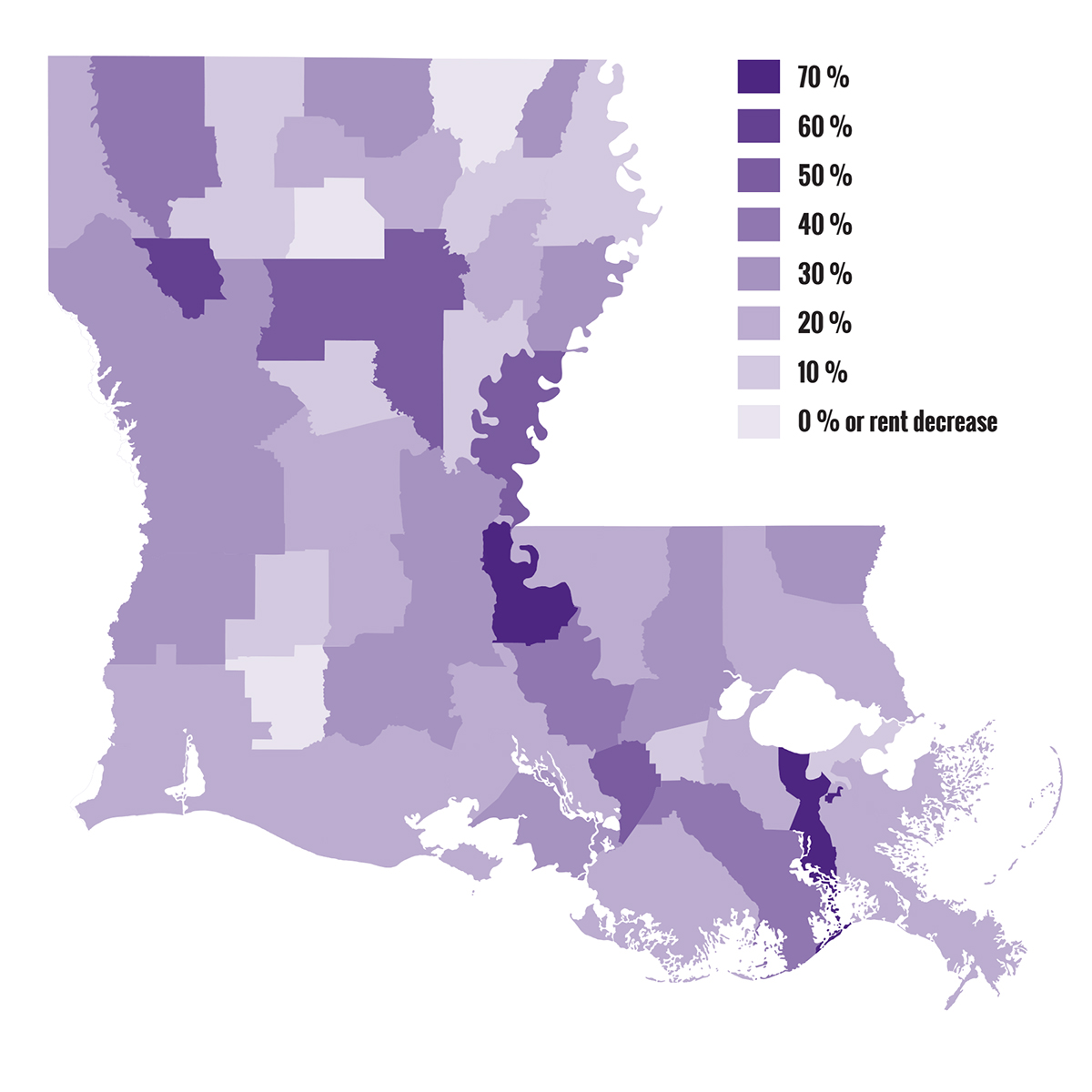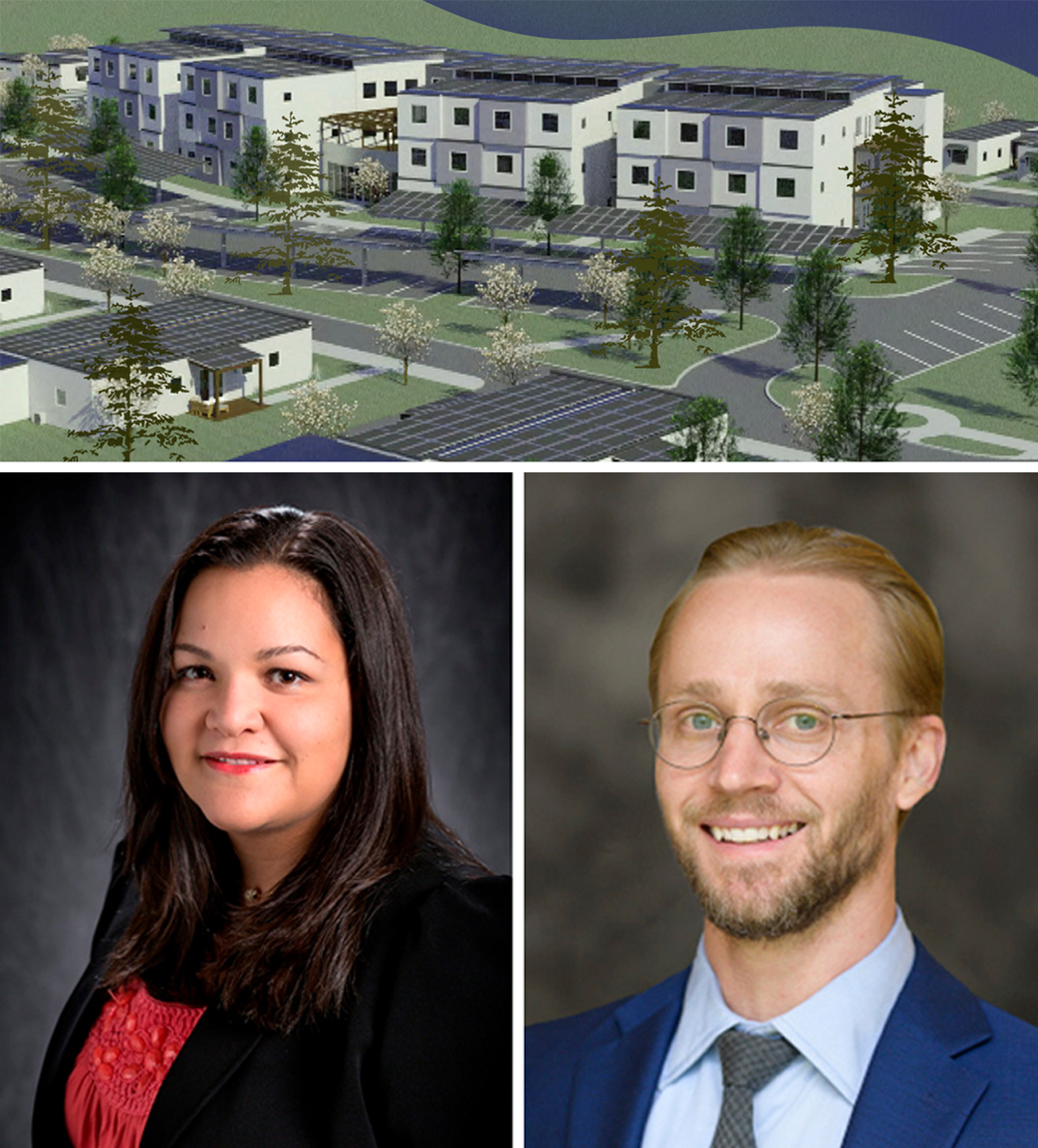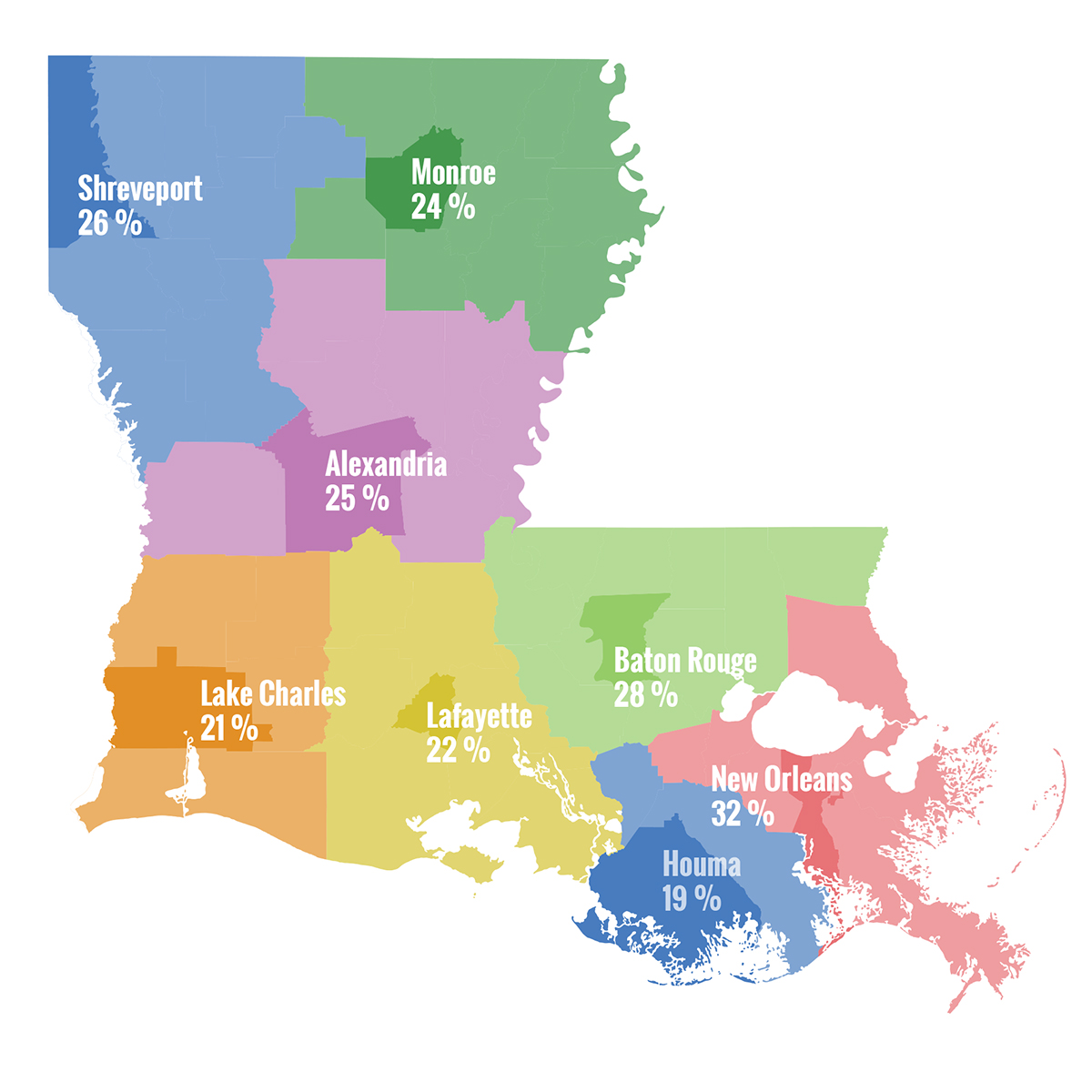Making Energy-Efficient Housing More Affordable for All
January 20, 2021
To close the affordable housing gap and also lower energy bills for low-income residents in Louisiana, it might take a solar village.

Gross rent, which includes energy bills and other utilities, has increased remarkably in all but a few Louisiana parishes since 2010, according to the Louisiana Housing Needs Assessment, which LSU researchers conduct for the Louisiana Housing Corporation, a state agency. In Jefferson and Pointe Coupee, the increase is about 70%.
The affordable housing crisis looks a little different in Louisiana than it does across the nation. Every eighth residence is a mobile home—more than twice the national average—while only 1 in 25 residents (less than half the national average) lives in a multi-family home, such as an apartment building, where optimization in construction on a bigger scale could be a key to affordability. Costs for housing have also risen sharply in most Louisiana parishes since 2010, with incomes hardly keeping up. Every fifth homeowner and most renters are now what’s called “cost-burdened” or “rent-stressed” as they spend more than a third of their total income on housing. Importantly, this includes utilities—energy bills (gas and electric), water, and sewer service.
An inherent challenge is how often energy-efficiency stands at odds with affordability.
Louisiana now ranks fifth in the nation in rent stress, according to the most recent
Louisiana Housing Needs Assessment, carried out by LSU researchers on request by the Louisiana Housing Corporation, LHC, a state agency created in 2011 to advance housing policy, merging what was
then known as the Louisiana Housing Finance Agency with Louisiana’s Office of Community
Development and other housing programs. The agency’s stated mission is to ensure that
“every Louisiana resident is granted an opportunity to obtain safe, affordable, and
energy-efficient housing.” An inherent challenge is how often energy-efficiency stands
at odds with affordability.
“The relationship between affordability and energy efficiency is not straightforward,”
said Roy Heidelberg, associate professor and chair of the Department of Public Administration
in the LSU E. J. Ourso College of Business and lead author of the Louisiana Housing
Needs Assessment. “An energy-efficient home could demand a higher contract rent while
an energy-inefficient one might cost more in utilities.”
Median rent—including utilities—has risen $88 in less than a decade in Louisiana.
In the most densely populated parishes surrounding the larger cities, “extreme rent
stress” where more than half of one’s income is spent on housing, ranges from around
20% in Terrebonne (Houma), Calcasieu (Lake Charles), and Lafayette to about 25% in
central and northern Louisiana, including Rapides (Alexandria), Ouachita (Monroe),
and Caddo (Shreveport). In Jefferson (New Orleans) and East Baton Rouge, which have
the biggest populations, around 30% of rental households are extremely rent-stressed.
Working a minimum-wage job in Jefferson Parish now means spending, on average, 16
workdays out of a total 19 to 22 workdays in any given month on housing—median gross
rent has risen 68% in the parish in the last decade. This leaves between three and
six workdays to make enough money to pay for food, healthcare, clothes, transportation,
and other essentials.
“Energy-efficiency and affordable housing access are vital to the state and the health
and wellness of Louisiana’s families," said LHC Executive Director E. Keith Cunningham,
Jr. “LHC's Weatherization Assistance Program (WAP) provides energy efficiency improvements
to approximately 700 low-income households annually at a total program cost of over
$18 million. Our Low-Income Home Energy Assistance Program (LIHEAP) has provided over
$100 thousand emergency energy assistance payments to approximately 60 thousand qualifying
low-income households for a total program cost of over $129 million. These programs
have provided approximately $147 million in long-term energy-efficient housing improvements
to more than 2,100 households and 400 thousand emergency reimbursements of utility
costs across four years.”
“Solving Louisiana's affordable housing crisis will only be accomplished through thoughtful
innovation and unique collaboration from our public and private-sector partners,”
Cunningham continued. “We are happy to continue our work with LSU, which represents
a genuine statewide objective.”

Isabelina Nahmens’s (left) team is bringing the latest technological advances in energy efficiency to affordable housing in modular, multi-family solutions (top) for Louisiana and the nation to help bridge the affordable housing gap and lower residents’ energy bills. Roy Heidelberg (right) conducted the two most recent Louisiana Housing Needs Assessments for the state.
As a driver of research and development for the state of Louisiana, LSU is working
on solutions to the affordable housing crisis in innovative ways. Isabelina Nahmens,
professor of industrial engineering at LSU, received a large grant from the U.S. Department
of Energy this year to develop a practical and affordable modular construction system
for multi-family, energy-efficient housing.
“We’re trying to remove the stigma and altogether wrong idea that affordable housing
and modular construction is low-quality and something you have to settle for,” Nahmens
said. “It doesn’t have to be that way. A modular home is often better built, and also,
it can be beautiful. We just have to figure out the right formula to get energy-efficient,
high-performance homes—smart homes, if you will—within the reach of everybody.”
“What’s remarkable about this project is how it’s combining energy-efficiency and affordable housing at scale.”—Alison Donovan, senior consultant, VEIC
For this project, sponsored by the U.S. Department of Energy’s Office of Energy Efficiency
and Renewable Energy, Nahmens partnered with VEIC in Vermont (a non-profit formerly
known as the Vermont Energy Investment Corporation), builders, and the National Renewable
Energy Laboratory in Colorado. The modular construction solutions they’re now working
on could benefit residents in Louisiana as well as across the nation.
“What’s remarkable about this project is how it’s combining energy-efficiency and
affordable housing at scale,” said Alison Donovan, a senior consultant at VEIC. “We’re
not talking about super-insulated and high-performance homes built for a million dollars.
It’s about bringing the benefits of that technology to affordable housing, which is
at the heart of our work. In many ways, this is a social justice issue.”
The team’s goal is to work with industry partners and American factories to come up
with homes that are at least 50% more energy-efficient—both in construction and once
in use—than the current code (the 2018 International Energy Conservation Code, or
IECC) at no additional cost. They have also received support from the U.S. Department
of Housing and Urban Development (HUD) to explore the advantages of installing solar
panels on modular homes directly in the factory as opposed to in the field.
“These add-on technologies are often installed at construction sites where you have
lots of different trades and several independent companies working under one general
contractor,” Nahmens said. “This often makes for uneven quality across a subdivision,
and no matter how energy-efficient each component might be, that efficiency is easily
lost if the components aren’t installed right. You can put in the best windows in
the world, but if you don’t fit them properly, they’re just expensive windows.”
The “solar village” idea her team is working on will be all-electric, with triple-pane
windows, steel siding, and air-source pumps for heating and cooling. By putting as
many components as possible together in the factory (what the industry calls “upstream”),
multiple efficiencies can be achieved. From the structural part of the house to the
finishings (flooring, appliances, cabinets, etc.)—everything can come together at
the factory.

Percentage of extremely rent-stressed people (who spend more than half of their income on rent and utilities) in the most populous parishes, surrounding the bigger cities, in each of the eight regions surveyed in the Louisiana Housing Needs Assessment.
“It’s a no-brainer,” Nahmens said. “You have a production line with skilled labor,
and all of the materials get delivered in bulk to one place, so you get more quality
control and lower prices than if dealing with separate vendors. We can gain a lot
of operational efficiencies at the factory level, so the more we can do there, the
better.”
“This is really the whole idea behind the benefit of modular housing,” she continued.
“But ‘low-cost’ isn’t enough. Homes must be energy-efficient to be truly affordable,
and this has huge implications for health, too.”
“... We want the homes to be energy-efficient, so people don’t pay tons of money for their energy bills, which leaves less money left over for healthy food and healthcare. Energy-efficiency and affordability affects all facets of people’s lives.”—Isabelina Nahmens, professor, LSU Department of Mechanical & Industrial Engineering
Energy efficiency is closely tied with the “tightness” of a home, yet just sealing
and insulating a home introduces other challenges with indoor air quality. While leaky
homes allow dirty air to sneak in through dirty gaps, such as inside walls where critters
may nest and dust tends to settle, tightly sealed and insulated homes must be built
to bring in fresh air and remove moisture for a healthy indoor environment. To do
this, additional labor and more sophisticated equipment are needed, which can increase
the construction cost of a home unless the process is streamlined—making this an ideal
challenge for modular construction, according to Nahmens.
“In Louisiana, low-income residents are disproportionately affected by hot and humid
weather—as well as flooding and hurricanes,” Nahmens said. “We don’t want people living
in leaky homes, period, and we want the homes to be energy-efficient, so people don’t
pay tons of money for their energy bills, which leaves less money left over for healthy
food and healthcare. Energy-efficiency and affordability affects all facets of people’s
lives.”
Donovan agreed, calling LSU’s Nahmens “the best” at bringing residents’ needs, research,
and industry together:
“Isa is our national expert in lean manufacturing. She brings the real-world experience
of working with industry, which helps us make sure that our energy-efficient affordable
housing solutions will not only be useful, but actually used.”